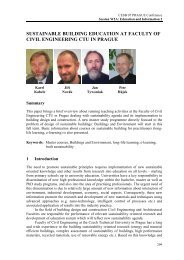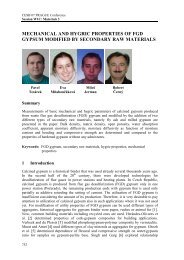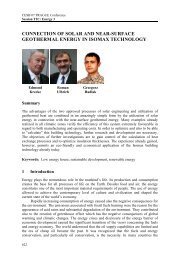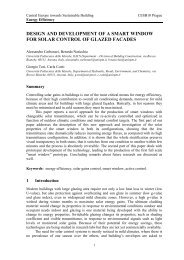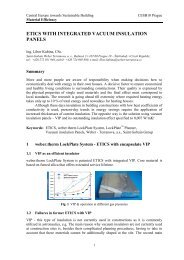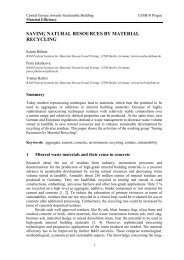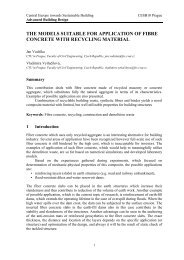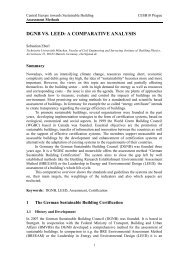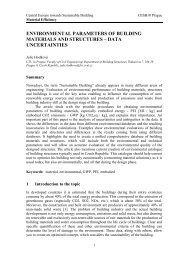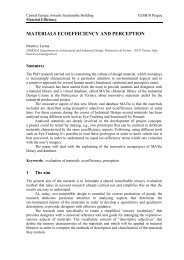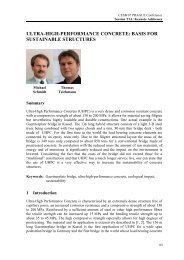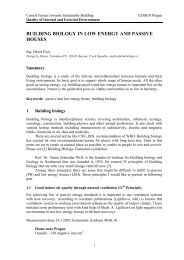sustainable building design strategies for pakistan
sustainable building design strategies for pakistan
sustainable building design strategies for pakistan
You also want an ePaper? Increase the reach of your titles
YUMPU automatically turns print PDFs into web optimized ePapers that Google loves.
Central Europe towards Sustainable Building CESB10 Prague<br />
Policy and Legislation<br />
SUSTAINABLE BUILDING DESIGN STRATEGIES FOR<br />
PAKISTAN<br />
Muhammad Ali Tirmizi<br />
Asst. Professor, Department of Architecture, National College of Arts, 4 The Mall, Lahore-54500,<br />
tirmizi@nca.edu.pk; tirmizi@aaschool.ac.uk<br />
Summary<br />
The OEDC has recently estimated that <strong>building</strong>s today account <strong>for</strong> over 40% of energy<br />
consumption in the world, and are responsible <strong>for</strong> about 45% of all carbon emissions, 40%<br />
of all freshwater consumption, 70% of all timber consumption, 50% of world’s material<br />
consumption and are responsible <strong>for</strong> 40% of all human-produced waste (OECD1999).<br />
However, this quantity of energy consumed can be greater in more industrialized<br />
countries due to their energy needs, while the proportion of energy usage by <strong>building</strong>s in<br />
developing countries is comparatively higher due to inefficiency of systems and is more<br />
significant than the developed countries due to prevailing extreme shortage of energy. The<br />
<strong>building</strong> sector consumes more than 43% of total energy produced within Pakistan while<br />
10% is used <strong>for</strong> manufacturing and transportation of <strong>building</strong> components & materials<br />
(World Resources Institute. 2007).<br />
It is a matter of common experience that a large majority of new <strong>building</strong>s<br />
constructed in Pakistan are not <strong>design</strong>ed in accordance with local climatic conditions.<br />
Excessive use of concrete and glass, high levels of illumination and heavy reliance on<br />
space conditioning are common feature of our <strong>building</strong>s. This means that owners and<br />
occupants consume extra energy to make them com<strong>for</strong>table <strong>for</strong> living. ENERCON has<br />
estimated that improved <strong>building</strong> <strong>design</strong> can reduce <strong>building</strong> energy bills by 20% and this<br />
figure can be raised to 50% by use of efficient appliances (ENERCON2008).<br />
Energy Efficient Sustainable Buildings where at one hand can reduce the energy<br />
burden, on other can avoid global warming, improve local air quality, retard global climate<br />
change and save consumers money. The choices we make in <strong>design</strong>ing and constructing<br />
new <strong>building</strong>s (and renovating old ones) will impact the global climate directly..<br />
Keywords: Energy Efficiency in Buildings, Green Architecture, Sustainable Buildings,<br />
Sustainable Building Materials<br />
1 Introduction<br />
Sustainable Building Design (Green Architecture) is a general term that describes<br />
environmentally-conscious <strong>design</strong> techniques in the field of architecture. Sustainable<br />
architecture is framed by the larger discussion of sustainability and the pressing economic<br />
and political issues of our world. In the broad context, <strong>sustainable</strong> architecture seeks to<br />
minimize the negative environmental impact of <strong>building</strong>s by enhancing efficiency and<br />
moderation in the use of materials, energy, and development space. Most simply, the idea<br />
of sustainability, or ecological <strong>design</strong>, is to ensure that our actions and decisions today do<br />
not inhibit the opportunities of future generations (Doerr Architecture, 2003). This term<br />
1
Central Europe towards Sustainable Building CESB10 Prague<br />
Policy and Legislation<br />
can be used to describe an energy and ecologically conscious approach to the <strong>design</strong> of the<br />
built environment (Dublin Institute of Technology, 2001).<br />
Today energy efficiency over the entire life cycle of a <strong>building</strong> is the most important<br />
single goal of <strong>sustainable</strong> architecture. Architects use many different techniques to reduce<br />
the energy needs of <strong>building</strong>s and increase their ability to capture or generate their own<br />
energy.<br />
2 Our Buildings Today<br />
The OEDC has recently estimated that <strong>building</strong>s today account <strong>for</strong> over 40% of energy<br />
consumption in the world (Fig. 1) and are responsible <strong>for</strong> about 45% of all carbon<br />
emissions, 40% of all freshwater consumption, 70% of all timber consumption, 50% of<br />
world’s material consumption and are responsible <strong>for</strong> 40% of all human-produced waste<br />
(OECD, 1999).<br />
Fig. 1 Our Buildings Today World Over<br />
However, this quantity of energy consumed can be greater in more industrialized countries,<br />
<strong>for</strong> example in UK 56% of all energy produced is used to operate <strong>building</strong>s and 10% of all<br />
the energy produced is used to manufacture <strong>building</strong> materials. There<strong>for</strong>e over two third of<br />
all UK energy use, stems from or is associated with <strong>building</strong> construction and use. While<br />
<strong>building</strong>s in the United States consume 39% of America's energy and 68% of its electricity,<br />
while 15% is used in manufacturing and transporting <strong>building</strong> materials, furthermore,<br />
<strong>building</strong>s in USA generate 38% of the carbon dioxide, 49% of the sulphur dioxide, and<br />
25% of the nitrogen oxides found in the air. Europe is lagging behind by consuming 42%<br />
of its energy to operate <strong>building</strong>s and 13% associated with <strong>building</strong> materials (OECD<br />
2006).<br />
The proportion of energy usage by <strong>building</strong>s in developing countries is<br />
comparatively higher due to inefficiency of the systems and is more significant than the<br />
developed countries due to prevailing extreme shortage of energy (Fig. 2). The <strong>building</strong><br />
2
Central Europe towards Sustainable Building CESB10 Prague<br />
Policy and Legislation<br />
sector consumes more than 43% of the total energy produced within Pakistan while 10% is<br />
used <strong>for</strong> manufacturing and transportation of <strong>building</strong> components & materials (World<br />
Resources Institute, 2007).<br />
Pakistan<br />
Europe<br />
USA<br />
Building Material Production Building Ope<br />
10<br />
13<br />
15<br />
Fig. 2 Energy Consumption in Buildings<br />
It is a matter of common experience that a large majority of new <strong>building</strong>s being<br />
constructed in Pakistan are not being <strong>design</strong>ed in accordance with our local climatic<br />
conditions. Excessive use of concrete and glass, high levels of illumination and heavy<br />
reliance on space conditioning are a common feature of our <strong>building</strong>s. This means that<br />
owners and occupants consume extra energy to make them com<strong>for</strong>table <strong>for</strong> living.<br />
ENERCON has estimated that improved <strong>building</strong> <strong>design</strong> can reduce <strong>building</strong> energy bills<br />
by 20% and this figure can be raised to 50 % by the use of efficient appliances<br />
(ENERCON Annual Report, 2008).<br />
Energy Efficient Sustainable Buildings where at one hand can reduce the energy<br />
burden, on the other can avoid global warming, reduce demand on the power grid and<br />
stress on natural gas supplies, improve local air quality, and save consumers money. The<br />
choices we make in <strong>design</strong>ing and constructing new <strong>building</strong>s (and renovating old ones)<br />
will affect energy use <strong>for</strong> many decades to come. Building <strong>design</strong> and construction provide<br />
by far the best and most cost-effective opportunity to build in energy-efficient features that<br />
will last <strong>for</strong> the lifetime of the <strong>building</strong>. Thus it is critical to make energy efficiency a<br />
fundamental part of <strong>sustainable</strong> <strong>building</strong> <strong>design</strong> and construction.<br />
3 Pakistan’s Construction Industry<br />
Pakistan’s construction industry is considerably a large industry in terms of economic<br />
expenditure, volume of raw materials/natural resources consumed, volume of materials and<br />
products manufactured, employment generated, environmental impacts, etc. Large variety<br />
3<br />
39<br />
42<br />
43
Central Europe towards Sustainable Building CESB10 Prague<br />
Policy and Legislation<br />
of materials are manufactured and consumed in the construction industry. It has been<br />
estimated that 18% of green house gas (GHG) emissions is contributed by the construction<br />
sector in Pakistan (ENERCON Annual Report, 2008). There is an ever-increasing demand<br />
<strong>for</strong> <strong>building</strong> materials. For example demand <strong>for</strong> houses has almost doubled in last two<br />
decades. Demand <strong>for</strong> the <strong>building</strong> materials like bricks, steel and cement has also been<br />
doubled.<br />
Usage of raw material <strong>for</strong> <strong>building</strong> components is consuming earth resources at a<br />
very high rate (Fig. 3) <strong>for</strong> example in case of brick-making activity, at present precious<br />
topsoil is being consumed rapidly. We have arable land comprising alluvial soils, black<br />
soil, red soil, laterite soil and desert soil. Alluvial, laterite and red soils are suitable <strong>for</strong><br />
brick making. Area under the soils suitable <strong>for</strong> brick making may not exceed 50% of the<br />
arable land. Brick-making activity to meet the present and future demand can result in<br />
consuming the fertile topsoil of arable land in about a century (Lunt, M. G., 1980, PP<br />
184.). Similarly the pressure on raw materials like limestone to manufacture cement and<br />
energy requirements to produce these materials has to be addressed.<br />
Production of <strong>building</strong> materials has slowly and steadily moved from highly<br />
decentralized and labour-intensive methods and processes to centralized, machinedependent<br />
industry mode. Centralized mode of production necessitates hauling of raw<br />
materials and distribution of finished materials over great distances. These activities again<br />
require expenditure of fossil fuels <strong>for</strong> transportation. Transportation of raw and finished<br />
<strong>building</strong> materials is another key issue that can contribute to cost of materials, increased<br />
energy requirements and environmental issues.<br />
Material Period<br />
Mud, stones, wood/thatch Prior 8000 BC<br />
Sun dried bricks 6000 BC<br />
Pottery products 4000–8000 BC<br />
Burnt bricks 4000 BC<br />
Lime 3000 BC<br />
Glass 1300 BC<br />
Iron products 1350 BC<br />
Lime-pozzolana cement 300 BC–476 AD<br />
Aluminum 1808 AD<br />
Portland cement 1824 AD<br />
Plastics 1862<br />
Fig. 3 Historical Development in Building Materials (Walker et al, 2000, pp. 27–35)<br />
Sustainability of the present mode of production, consumption and distribution of <strong>building</strong><br />
materials and currently adopted construction practices is questionable.<br />
4 Sustainable Alternatives<br />
Steel, cement, glass, aluminium, plastics, bricks, etc. are energy-intensive materials,<br />
commonly used <strong>for</strong> <strong>building</strong> construction. Generally these materials are transported over<br />
great distances. Extensive use of these materials can drain the energy resources and<br />
adversely affect the environment.<br />
4
Central Europe towards Sustainable Building CESB10 Prague<br />
Policy and Legislation<br />
On the other hand, it is difficult to meet the ever-growing demand <strong>for</strong> <strong>building</strong>s by<br />
adopting only energy efficient traditional materials (like mud, thatch, timber, etc.) and<br />
construction methods. Hence, there is a need <strong>for</strong> optimum utilization of available energy<br />
resources and raw materials to produce simple, energy efficient, environment friendly and<br />
<strong>sustainable</strong> <strong>building</strong> alternatives and techniques to satisfy the increasing demand <strong>for</strong><br />
<strong>building</strong>s.<br />
Some of the guiding principles in developing the <strong>sustainable</strong> alternative <strong>building</strong><br />
technologies can be summarized as follows:<br />
▪ Energy conservation;<br />
▪ Minimize the use of high energy materials;<br />
▪ Concern <strong>for</strong> environment,<br />
▪ Environment-friendly technologies;<br />
▪ Minimize transportation and maximize the use of local materials and resources;<br />
▪ Decentralized production and maximum use of local skills;<br />
▪ Utilization of industrial and mine wastes <strong>for</strong> the production of <strong>building</strong> materials;<br />
▪ Recycling of <strong>building</strong> wastes,<br />
▪ Use of renewable energy sources.<br />
Building technologies manufactured by meeting these principles could become <strong>sustainable</strong><br />
and facilitate sharing the resources especially energy resources more efficiently, causing<br />
minimum damage to the environment.<br />
5 Our Traditional/ Indigenous Sustainable Buildings<br />
Our traditional planning and <strong>building</strong> methods were often good examples of green<br />
architecture in their time, and represented good uses of local resources matched with local<br />
skills. Combined they produced a built environment which met people's needs. There are<br />
many lessons to be learnt that can contribute to meeting contemporary and future <strong>building</strong><br />
and planning needs (Ed. Paul Oliver, 1997). Our traditional/ historic <strong>building</strong>s were<br />
<strong>design</strong>ed to consume minimal of energy but were enabled to provide environmental<br />
com<strong>for</strong>t to its fullest.<br />
“In our traditional Buildings Environmental com<strong>for</strong>t against harsh weather condition is<br />
achieved by passive means through intelligent and innovative <strong>design</strong>s of <strong>for</strong>ms, fabrics,<br />
and fenestrations - making the best use of local materials and construction techniques<br />
(Qureshi. S, 2008)”<br />
Traditional <strong>building</strong>s, there<strong>for</strong>e, offer treasure of traditional wisdom to <strong>design</strong> energyefficient<br />
<strong>building</strong>s <strong>for</strong> today. Although solutions that we find in traditional <strong>building</strong>s may<br />
not be suitable to the present socio-economic and technical context, yet the principles on<br />
which those solutions were based are still relevant. There is a need to appropriate<br />
traditional wisdom in order to develop <strong>sustainable</strong> <strong>building</strong> <strong>design</strong>s <strong>for</strong> today.<br />
The best existing example of our traditional <strong>building</strong>s is Lahore Fort (Fig. 4) which<br />
provided Mughals with the best environmental com<strong>for</strong>t without consuming considerable<br />
energy, many Mughal and Sikh Havelis continued the tradition and Choona Mandi Haveli<br />
Complex (Fig. 5) is a very good living example of it.<br />
5
Central Europe towards Sustainable Building CESB10 Prague<br />
Policy and Legislation<br />
Fig. 4 Lahore Fort Fig. 5 Choona Mandi Haveli Complex<br />
Colonial Buildings further improved on the techniques when <strong>for</strong>eign technology was<br />
successfully amalgamated with local traditional wisdom of environmentally com<strong>for</strong>table<br />
Sustainable Building Design. National College of Arts, Lahore (NCA) (Fig. 6), Punjab<br />
University, Lahore Museum and Aitcheson College (Fig. 7) are very good working<br />
examples of this success.<br />
Fig. 6 National College of Arts, Lahore Fig. 7 Aitcheson College<br />
The careful study of indigenous architecture of composite climate of Lahore, particularly<br />
residential <strong>building</strong>s, reveals a unique example of the whole city; entire city responds to its<br />
climatic effects with its street pattern, thermal mass and mutual shading. Each house plan<br />
<strong>for</strong>m enhances thermal com<strong>for</strong>t through its courtyard planning as a major environmental<br />
approach. But after the industrial revolution, the modern built <strong>for</strong>ms changed and<br />
consumed a huge amount of energy.<br />
But factors such as demographic growth, shifts from rural to urban areas, natural and<br />
human-made resource depletion, and significant changes in expectations and life styles, all<br />
combine in their various ways to erode the viability of traditional approaches to <strong>building</strong><br />
<strong>design</strong>.<br />
6
Central Europe towards Sustainable Building CESB10 Prague<br />
Policy and Legislation<br />
This means that whilst there are aspects of<br />
traditional approaches that still work well, some<br />
aspects may have become inefficient or unworkable,<br />
or in general, un<strong>sustainable</strong> i.e. the local resources<br />
may no longer be available; the sheer concentration<br />
of people may require a different sort of <strong>building</strong> or<br />
simply more <strong>building</strong>s more quickly, or the source<br />
of finance may have changed or may be insufficient.<br />
Taken together, all these changes mean that a<br />
<strong>building</strong> method that worked well in the past in its<br />
given context may have now become difficult to<br />
af<strong>for</strong>d, build and maintain, and it may no longer<br />
meet the desired requirements of the family or<br />
community. Gradually it becomes clear that an<br />
alternative has to be found. It is very clear today that<br />
architects cannot build Hava Khana (air rooms) as of<br />
Haveli Nau Nihal Singh (Fig. 8) in a 5-10-20 Marla<br />
i.e. (1125-2250-4500 sq feet) house. Architects<br />
cannot have 20-30 feet high ceiling of Punjab<br />
University (Fig. 9) as They have to accommodate<br />
many floors in this height and also have height<br />
restrictions. Architects do not af<strong>for</strong>d the skylights of<br />
NCA galleries (Fig. 10) as they have to go<br />
multistory, they cannot create thermal mass of<br />
Lahore Fort as simply there is not enough space <strong>for</strong><br />
it and architects even cannot have the chamfered<br />
windows of the basement of Sethi Haveli as they do<br />
not have finances <strong>for</strong> it.<br />
This scenario tells that Architects have now<br />
got the limited resources and many approaches to<br />
shelter provision developed over the time require<br />
equipment, skills or capital that is inaccessible to the<br />
majority in Pakistan.<br />
6 Conclusion<br />
Blind usage of modern day technology and materials<br />
without understanding its potentials <strong>for</strong> being<br />
<strong>sustainable</strong> took away the embedded environmental<br />
com<strong>for</strong>t of our <strong>building</strong>s and we became dependent<br />
on more and more energy consumption <strong>for</strong> our<br />
environmental com<strong>for</strong>t which in turn is polluting our<br />
environment and is causing global warming on one<br />
hand while on the other is depleting our precious<br />
non-renewable energy resources.<br />
We as architects need to relearn the old tried<br />
and tested methods of <strong>design</strong>ing environmentally<br />
7<br />
Fig. 8 Haveli Naunihal Singh<br />
Fig. 9 Punjab University<br />
Fig. 10 NCA Skylights
Central Europe towards Sustainable Building CESB10 Prague<br />
Policy and Legislation<br />
com<strong>for</strong>table, energy efficient, <strong>sustainable</strong> <strong>building</strong>s, learning the <strong>sustainable</strong> principles<br />
from our traditional/ indigenous <strong>building</strong>s and applying them through modern day “state of<br />
the art” <strong>sustainable</strong> <strong>building</strong> materials.<br />
The Incorporation of simple energy efficient measures in new <strong>building</strong>s can reduce a<br />
significant amount of energy consumption in Pakistan. Building bye-laws needs to be<br />
re<strong>for</strong>med in accordance with quick guidelines <strong>for</strong> energy efficiency in <strong>building</strong>s and there<br />
is a need to recast the <strong>design</strong> courses in learning schools of architecture in Pakistan.<br />
References<br />
[1] DOERR ARCHITECTURE, Definition of Sustainability and the Impacts of Buildings; Doerr<br />
Publishers 2003<br />
[2] Dublin Institute of Technology “Sustainable Architecture and Simulation Modelling", Ken<br />
Beattie Publications, 2001<br />
[3] ED. PAUL OLIVER, Encyclopaedia of Vernacular Architecture of the World, Cambridge<br />
University Press, 1997.<br />
[4] ENERCON Annual Report, Govt. of Pakistan Press (2008)<br />
[5] ENERCON Annual Report, Govt. of Pakistan Press (2008)<br />
[6] LUNT, M. G., Stabilized Soil Blocks <strong>for</strong> Building Construction. Overseas Building Notes,<br />
1980, 184.<br />
[7] OECD, OECD Environmental Outlook to 2030, EarthLink, Paris, 1999<br />
[8] OECD, “Making city sense” in OECD Observer No 255, May, EarthLink, Paris, 2006<br />
[9] QURESHI, S. “Appropriating Traditional Wisdom <strong>for</strong> Sustainable Building Design” Book<br />
of Abstracts, SBD08, Liverpool, UK, Surkul Pubilshers, 2008<br />
[10] WALKER, P., VENKATARAMA R., MESBAH, A. AND MOREL, J., The case <strong>for</strong><br />
compressed earth block construction, Proceedings of the 6th International Seminar on<br />
Structural Masonry <strong>for</strong> Developing Countries, Bangalore, India, Allied Publishers, 2000, pp.<br />
27–35.<br />
[11] World Resources Institute. 2007. EarthTrends: Environmental In<strong>for</strong>mation. Available at<br />
http://earthtrends.wri.org. Washington DC: World Resources Institute.<br />
8



